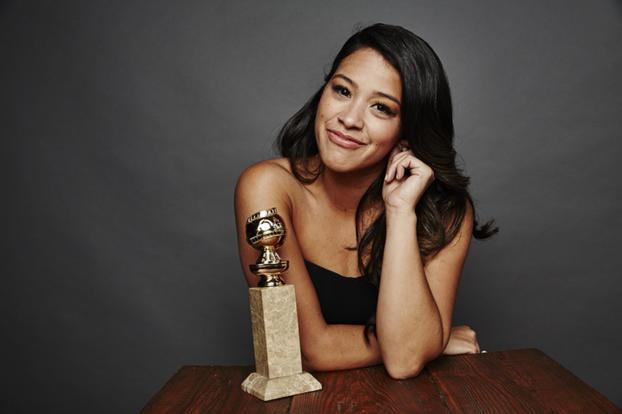2015 Fall TV Preview: Has the Latino Media Gap Been Bridged?
Posted on 08/25/2015 @ 07:45 PM

Photo Credit: Getty / Maarten de Boer
By: Aurora de Peralta, Education and Youth Leadership Programs Intern, LULAC National
As the 2015 Fall TV season approaches, network television is boasting a variety of new shows with more racial diversity. What’s even better is that Latinos haven’t been excluded from this boost in non-white casts. Three NBC series featuring Latina leads are scheduled to premiere this fall: Jennifer Lopez as a New York detective in Shades of Blue, America Ferrera as a retail employee in Superstore, and Eva Longoria as a telenovela star in Hot & Bothered.
These Latina-led television series follow what has been a groundbreaking year for Latino representation in mainstream media: Gina Rodriguez won a Golden Globe for her role in the CW’s Jane the Virgin; Cristela Alonzo premiered her eponymous ABC show as the only network series starring, created and produced by a Latina; and Sofia Vergara was ranked by Forbes--for the third year in a row--as the highest paid television actress.
But each of these landmark moments in entertainment still comes with a downside: despite Rodriguez’s Golden Globe, it’s still less than a handful of Latinos that get nominated for Academy Awards each year. Cristela Alonzo’s show was cancelled after one season due to lackluster ratings, and Sofia Vergara’s Modern Family character continues to represent no more than a caricature of the sexy Latina, complete with a thick accent and a sketchy immigrant heritage.
Worse still, these examples of Latino mainstream media representation are the exception to the rule: any Latino participation in mainstream English-language media is still stunningly low. According to a report by filmmaker/scholar Frances Negron-Mutaner, a review of top movies and television programs reveal that there are fewer Latino lead actors in the entertainment industry today than there were seventy years ago. And, whereas the Latino population grew 43% from 2000-2010, the rate of Latino media representation grew stagnant or declined proportionately. Even further, when Latinos are visible, they tend to be portrayed through decades-old stereotypes like law enforcement officers, cheap labor, and hypersexualized beings.
Negron-Mutaner bills this conundrum as “The Latino Media Gap”, and these upcoming network series aren’t doing a convincing job of bridging this divide: America Ferrera is starring as a low-wage service worker; Jennifer Lopez is advertised as a “sexy New York detective” gone bad; and Eva Longoria(who was placed under fire in 2013 for perpetuating stereotypes in her show, Devious Maids) seems set to turn the Latino cultural facet of the telenovela into cheap laughs for English-language audiences.
Yes, the success of a handful of stars like Gina Rodriguez is noteworthy, and there’s something to be said for the mere fact that network programs with Latino leads exist at all. But the rate of incorporation is still out of step with the growth of the Latino population, and those incorporated are still relegated to stereotypical portrayals that skews the public’s perception of this community.
It’s not easy to foster mainstream media representation that accurately reflects the Latino community without stereotyping and prejudice. ABC’s Cristela wasn’t just a show that featured a non-white cast: it challenged how television handles characters of color while still being entertaining, but it got cancelled.
In a blog post in response to the Cristela cancellation, Mexican-American Alonzo detailed the challenge of honest portrayals of race on television.
“I got messages from people that said I need to add ‘that crazy chola cousin we all have’ or telling me that I sold out my culture because my mom has a thick accent,” she wrote. “I didn’t have the ‘crazy cousin’ so I can’t write about that. And my mom had a thick accent on the show because she was from Mexico and couldn’t speak English.”
But despite the criticisms and low ratings, Alonzo’s show still managed to positively impact the community.
“I’ve also gotten messages from people that told me how much my show inspired them to do something with their lives. People told me that they decided to go to college for the first time, others told me that they’re going back to school.” she wrote. “I have to admit, I cried at some of those messages...If these people made these changes because of Cristela, then the show has served its purpose.”
Alonzo’s challenge is part of the constant struggle to create television that reflects the racial diversity of America without amplifying its problems with stereotyping and prejudice. Maybe the upcoming Fall 2015 network series will rise to the challenge, have stellar ratings and spur the creation of more Latino-focused programs in mainstream media--effectively bridging the Latino Media Gap.
Then again, maybe it’s safer to hold our breath until the premieres.
Aurora de Peralta is an Education & Youth Leadership Intern at the LULAC National Office in Washington, D.C. She graduated from American University in May 2015 with a degree in Spanish and Print Journalism, where she regularly wrote pieces aimed at improving racial representation in media.

Comments
Leave a Comment
You must be logged in to leave a comment.